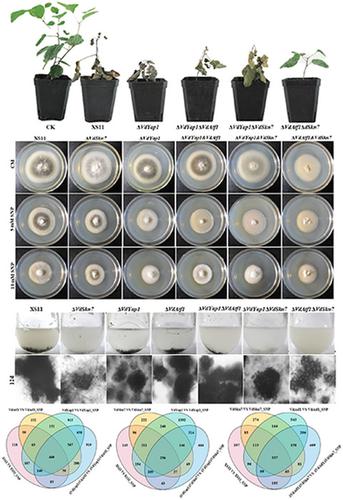当前位置:
X-MOL 学术
›
Mol. Plant Pathol.
›
论文详情
Our official English website, www.x-mol.net, welcomes your
feedback! (Note: you will need to create a separate account there.)
Convergent and distinctive functions of transcription factors VdYap1, VdAtf1, and VdSkn7 in the regulation of nitrosative stress resistance, microsclerotia formation, and virulence in Verticillium dahliae.
Molecular Plant Pathology ( IF 4.8 ) Pub Date : 2020-09-20 , DOI: 10.1111/mpp.12988 Chen Tang 1 , Xianjiang Jin 1 , Steven J Klosterman 2 , Yonglin Wang 1
Molecular Plant Pathology ( IF 4.8 ) Pub Date : 2020-09-20 , DOI: 10.1111/mpp.12988 Chen Tang 1 , Xianjiang Jin 1 , Steven J Klosterman 2 , Yonglin Wang 1
Affiliation

|
Reactive oxygen/nitrogen species (ROS/RNS) play a fundamental role in plant–fungal interactions. How pathogenic fungi manipulate plant‐derived ROS/RNS is of importance to the outcomes of these interactions. In this study, we explored the individual and combined contributions of three transcription factors, VdAtf1, VdYap1, and VdSkn7, in the response to ROS/RNS, microsclerotia formation, and virulence in the plant wilt pathogen Verticillium dahliae. We showed that VdYap1 is essential for ROS response. Additionally, mutants lacking any combination of the three genes shared significant hypersensitivity to nitro‐oxidative stress like sodium nitroprusside dehydrate and double deletions lacking VdYap1 and VdAtf1 resulted in further increased sensitivity to ROS. Double deletion of VdAtf1 and VdSkn7 reduced melanin production and virulence while simultaneous lack of VdSkn7 and VdYap1 disrupted nitrogen metabolism and ROS resistance. Finally, comparison of transcriptional profiles of the respective single or double mutants in response to nitro‐oxidative stress revealed that the three transcription factors are involved in denitrification of nitrated alkanes and lipids to protect against nitro‐oxidative stress. Taken together, our results demonstrate convergent and distinctive functions of VdYap1, VdAtf1, and VdSkn7 in V. dahliae, and provide new data on their roles in response to ROS/RNS in fungi.
中文翻译:

转录因子VdYap1,VdAtf1和VdSkn7在调节大黄萎病菌的亚硝化抗性,微核盘菌形成和毒力中具有收敛和独特的功能。
活性氧/氮物质(ROS / RNS)在植物与真菌的相互作用中起着基本作用。致病真菌如何操纵植物来源的ROS / RNS对这些相互作用的结果至关重要。在这项研究中,我们探索了三种转录因子VdAtf1,VdYap1和VdSkn7的个体和联合作用,以响应ROS / RNS,微菌核形成和植物枯萎病菌黄萎病菌的毒力。我们表明,VdYap1对ROS应答至关重要。此外,缺乏这三个基因的任何组合的突变体对硝化氧化钠脱水都具有明显的对硝基氧化应激的超敏性,而缺少VdYap1和VdAtf1的双重缺失导致对ROS的敏感性进一步提高。VdAtf1和VdSkn7的双重缺失减少了黑色素的产生和毒力,而同时缺乏VdSkn7和VdYap1破坏了氮的代谢和ROS的抵抗力。最后,比较单个突变体或双突变体对硝基氧化应激的转录谱,发现这三个转录因子参与硝化烷烃和脂质的反硝化反应,以防止硝基氧化应激。两者合计,我们的结果表明VdYap1,VdAtf1和VdSkn7在大丽花中的收敛和独特的功能,并提供了有关它们对真菌中ROS / RNS的响应的新数据。
更新日期:2020-10-12
中文翻译:

转录因子VdYap1,VdAtf1和VdSkn7在调节大黄萎病菌的亚硝化抗性,微核盘菌形成和毒力中具有收敛和独特的功能。
活性氧/氮物质(ROS / RNS)在植物与真菌的相互作用中起着基本作用。致病真菌如何操纵植物来源的ROS / RNS对这些相互作用的结果至关重要。在这项研究中,我们探索了三种转录因子VdAtf1,VdYap1和VdSkn7的个体和联合作用,以响应ROS / RNS,微菌核形成和植物枯萎病菌黄萎病菌的毒力。我们表明,VdYap1对ROS应答至关重要。此外,缺乏这三个基因的任何组合的突变体对硝化氧化钠脱水都具有明显的对硝基氧化应激的超敏性,而缺少VdYap1和VdAtf1的双重缺失导致对ROS的敏感性进一步提高。VdAtf1和VdSkn7的双重缺失减少了黑色素的产生和毒力,而同时缺乏VdSkn7和VdYap1破坏了氮的代谢和ROS的抵抗力。最后,比较单个突变体或双突变体对硝基氧化应激的转录谱,发现这三个转录因子参与硝化烷烃和脂质的反硝化反应,以防止硝基氧化应激。两者合计,我们的结果表明VdYap1,VdAtf1和VdSkn7在大丽花中的收敛和独特的功能,并提供了有关它们对真菌中ROS / RNS的响应的新数据。











































 京公网安备 11010802027423号
京公网安备 11010802027423号